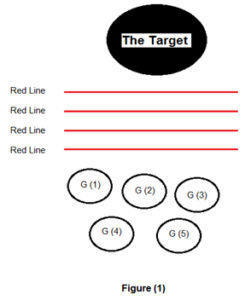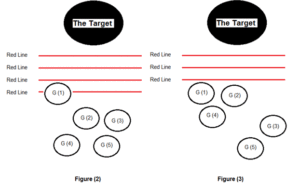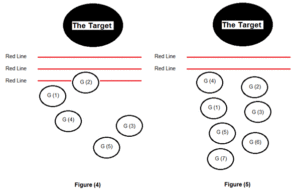Let’s assume that a group of people are standing on the bank of a river and want to move to the other side, butcannot find a means of transport, and cannot cross it by swimming sincethe river well-known for its “Deadly Myths”. While everyoneis standingby the river not knowing what to do, one of them got up and jumped in the river! Spectators thought that he is going to be a prey for death! However,he continued to swim until he reached the other shore safely. After what he did, other people were encouraged to do the same, and thus he managed tobuild a bridge of determination and break the fear. Furthermore, others after him were able to end this stage in order to begin the next one after crossing the river.
“Working Groups” buildbridges that will strengthen the “Change Movements” and weaken the “Power of the Regime”, ones that can break more of the “Red Lines”and after whichthe “Forces of change” can proceed.For example, when a regime prohibits protesting against his own practices, the movement of a “Work Group” towards the street, even by symbolic numbers, suggests tothe wide audience the possibility to act. Suchmovementsform anew bridge being built, and can convince the hesitated and restrained audience and forces of change that going to the street is something possible.In addition, some internet websitesstartalonein order to make a bridgefor using the internet in facing the regime and supporting the “Movements of Change”. This bridge encourages many others, afterwards, to use the internet as one of the arenas of confrontation. Thus, bridges can be built one after another to pave the road for the “Resistance Forces” to make the dictatorial regimes lose another red line that is being destroyed.


Figure (1) illustrates how there are “Red Lines” that stand between the “Transformation Movements and Work Groups” (G1, G2, G3…etc.) and achieving their goals. These “Red Lines” might be the “Sources of Power” to the regime, like legitimacy, money, oppression…etc. Essentially, they form a psychological barrier preventing communities from thinking of “Resistance”, as they define the ceiling of the movements’ demands.

In Figure (2) we notice that Group (1) decided to try to penetrate one of the “Red Lines”, putting in mind success or failure. While Figure (3) explain show Group (1) succeeded in breaking one of the red lines, and then proceeded in the space it won by advancing the rest of the groups and movements.
The same Group (1) might or might not be able to break a new line; however it did encourage other groups to break the “Red Lines” by assuring to them the possibility of act.

Group (1) did not proceed, however it built a bridge other groups used to cross over. By then Group (2) thought to make an initiative to break a new line as in Figure (4), and indeed it did. As a result other groups stepped forward as in Figure (5). We notice in the latter Figure that whenever “Red Lines” get broken, people are encouraged to form new qualitative groups. Here, the appearance of the new groups (5) and (6) was incited by what their formers did.
That is how the “Project of Change” forges ahead as a result of the groups’ work which builds society’s ability to act, induces it to experiment, and reduces the burden so that it is not borne by an individual movement or group by itself. The process of “Building Bridges” continues until the last “Red Line” is broken. Hence, society by all its different forces reaches its target, which is the liberation from tyranny.
Raising the Ceiling of the Political Challenge:
Challenges are usually a strong reason for development, the methods used by “Working Groups” has a major role in developing the performance of community, and raising it to a qualitative level. The emergence of new groups which implements qualitative work creates an external challenge for other groups, one that can pushthem towards development and innovation.
The idea of “Work Groups” has a great role in mobilizing the movements and parties that reduce the ceiling of their activities and demands, or suffer from weak political performance. The emergence of a new “Work Group” with a fresh, bold, and qualitative initiative represents an external challenge for the movement or party, and form an internal pressure factor. Accordingly, the members of this movement or party will impose pressure on their leaders, and demand to carry out similar work, since they see that they are more entitled to performsuch role.
This interaction resulting from “Work Groups” actions does not only move the inactive segments of society, but also affects the movements which fears the withdrawal of their members, and decide to take the initiative by acting in a way befitting its status in the eyes of their members, and observers. So, this method of “Work Groups” raises the ceiling of claimant and strengthens the intensity of the political challenge.
The nature of the conflict with the dictatorial regime requires training people on the “Team Work” style to build “Bridges of Change”, which encourage others to do their role of building new bridges. Hence, the “Process of Change” moves across the bridges of these diverse groups. So, the spirit of strategic partnership is the dominant one among all groups, since every one is a partner in the making of change.
Important notes:
- “Work Groups” who take it upon themselves to break the “Red Lines” might crash on the barricades of one of these lines.
- A group might succeed in breaking one of the “Red Lines”, with which its historic role ends. It will not seek to break the rest of the lines;moreover it might dismantle itself afterwards. Its members can join new groups to implement new work, being aware that they as a coherent group will not perform more than what they already did, but might do better in other forms.
- Usually no single group is capable of breaking all the lines, a group may succeed in breaking one, but might not be able to overcome the next, while another group manages to do so. Therefore, the ability of a group to break a “Red Line” does not mean it is capable of breaking all of them.
- Some fear that the “Work Groups” method leads to chaos, although their concern is valid in the case of “Violent Struggle”, it is not true in the case of “Non-Violence”. This method requires a large area of training on freedom, and “WorkGroups” are the safety valve until people find an outlet to achieve what they want in a “Non-Violent” way and a vast area of freedom which can set creativity free. It is a training to build the future of a free society where the mind of every worker is respected, the effectiveness of the political movements is revived, and new leaderships mature and exercise political work that accepts pluralism.
Also, this method is the born child of the “Effective Cluttering and Proper Assembly” strategy, which was necessitated by the nature of the conflict with the dictatorial regime. This committed scattering to the “Non-Violence Movement” policies is suitable for this stage which requires mobilizing the masses & transferring them from the “Spectator’s Seat” to the “Actor” one.After a period of mobility, which comes from “Multiple Sources with Unity of Purpose”, gathering happens automatically as soon as the opposition parties meet on a specific agenda at acritical moment which calls for the formation of a strong front. We should not rush into this issue before the popular movement reaches to the critical point, after which we hope to rearrange the papers, and gather these scattered groups in a decisive, definitive, and thoughtful act, not a maneuvering one.
Scattered “Work Groups” (Effective Cluttering) has an effective role in one of the stages of struggle; it is also one of the conflict tools. Forming fronts is one of the conflict tools as well, each one of these tools is beneficial for a certain stage and if both are not used effectively in the appropriate time, “Forces of Change” will lose one of their powerful tools.
There is no doubt that the “Forces of Change” standing for this great message need to be trained for that kind of work, and should be engaged in small experiments before it reaches the decisive final moment in the “Non-Violence” War. We should put our trust in the people and in their ability to participate in a civilized manner in the “Movement of Change”. We should believe that there are many leading minds who are capable of doing and contributing to the creationof the required change, that “Free Activists” are characterized by conscious acts and are aware of what they are doing, and their movement in the fields will be an impetus to the “Wheel of Change”.
Whether people who feel jealous decided to support the “Movement of Change” in a direct way (Join them) or establish supportive “Working Groups”, the spirit of working in a team ensures the power of the required activity to bring down the dictatorial regimes.
By Ahmad Abd Al Hakeem, Hisham Mursi, and Wael Adel.
Translated by Rana Mohammed
May 15th, 2007